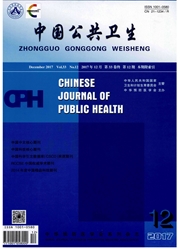

 中文摘要:
中文摘要:
目的了解新疆北疆牧区维吾尔族、哈萨克族、汉族居民膝骨性关节炎(KOA)的患病现状,为当地卫生行政部门制定相关医疗政策提供依据。方法采用整群随机抽样方法对在新疆北疆牧区伊犁、塔城和阿勒泰3个地区抽取的3 402名维吾尔族、哈萨克族、汉族常住居民进行问卷调查和膝关节检查。结果新疆北疆牧区居民KOA患病率为27.0%;男性居民KOA患病率为18.6%,低于女性居民患病率的34.8%,差异有统计学意义(χ^2=113.36,P〈0.01);38~49、50~59和≥60岁居民KOA患病率分别为21.5%、31.6%和31.7%,差异有统计学意义(χ^2=46.59,P〈0.01);伊犁、塔城和阿勒泰地区KOA患病率分别为24.2%、37.7%和19.3%(176/912),不同地区居民KOA患病率比较,差异有统计学意义(χ^2=93.01,P〈0.01);维吾尔族、哈萨克族和汉族居民KOA患病率分别为29.6%、35.1%和18.1%,不同民族居民KOA患病率比较,差异有统计学意义(χ^2=89.83,P〈0.01)。结论新疆北疆牧区维吾尔族、哈萨克族、汉族居民KOA患病率较高,不同性别、年龄、民族、地区间均有差异。
 英文摘要:
英文摘要:
Objective To examine the prevalence of knee osteoarthritis( KOA) among inhabitants of Uighur,Kazak,and Han nationality in pastoral areas of north of Xinjiang Uygur Autonomous Region( Xinjiang) and to provide evidences to local health administrative departments for making relevant health policy. Methods Cluster random sampling method was used to select 3 402 Uighur,Kazak,Han residents in Yili,Tacheng,and Aletai in pastoral areas of north Xinjiang for a questionnaire survey and examination of knee joint. Results In the participants,the prevalence of KOA was27. 0%; the prevalence of KOA in the males was 18. 6% and significantly lower than that in the females( 34. 8%)( χ^2= 113. 36,P〈0. 01); the prevalence rates of KOA were 21. 5%,31. 6%,and 31. 7% for the residents aged 38- 49,50- 59,and more than 60 years,with a statistically significant difference among different age groups( χ^2= 46. 59,P〈0. 01); the KOA prevalence rates were 24. 2%,37. 7%,and 19. 3% for the residents living in Yili,Tacheng and Aletai area,with statistically significant regional difference( χ^2= 93. 01,P〈0. 01); the KOA prevalence rates were 29. 6%,35. 1%,and 18. 1% for Uygur,Kazak and Han residents,with a statistically significant difference among different ethnic groups( χ^2= 89. 83,P〈0. 01). Conclusion The prevalence rate of KOA is high and there are gender,age,ethnic,and regional differences in the prevalence rate among Uygur,Kazak,and Han residents in pastoral areas of north Xinjiang.
 同期刊论文项目
同期刊论文项目
 同项目期刊论文
同项目期刊论文
 期刊信息
期刊信息
